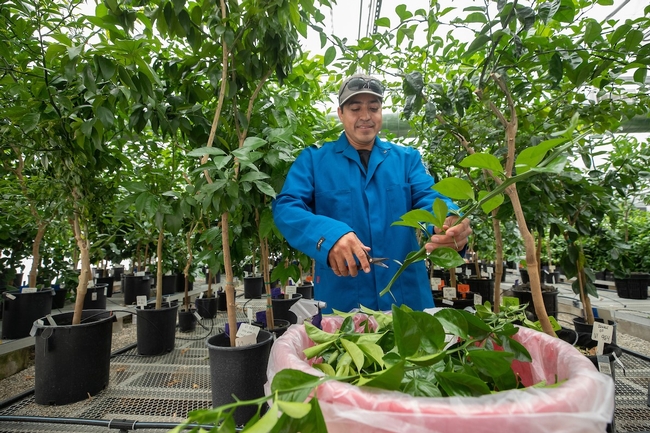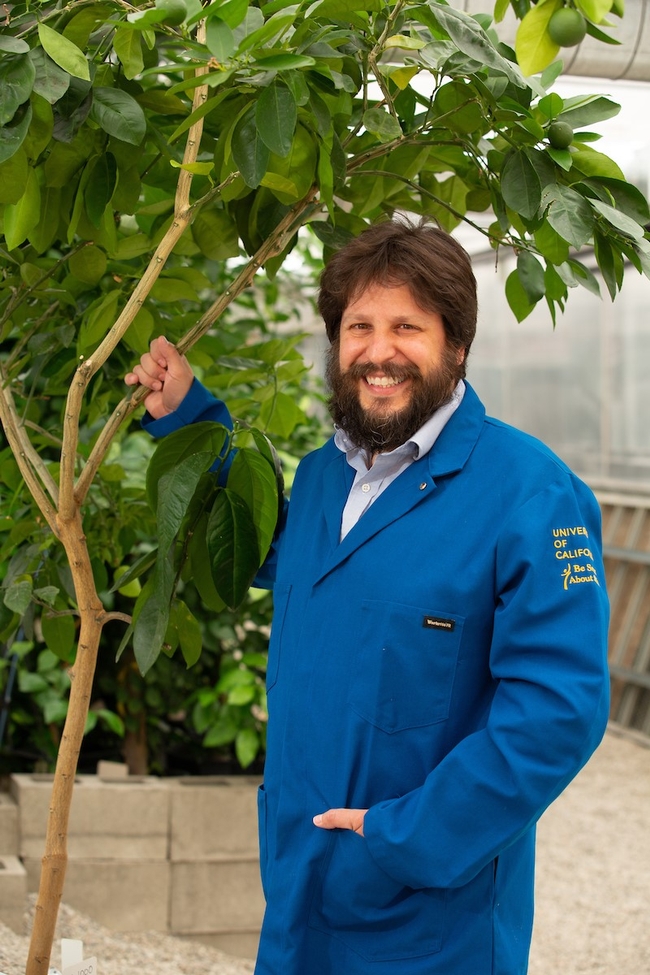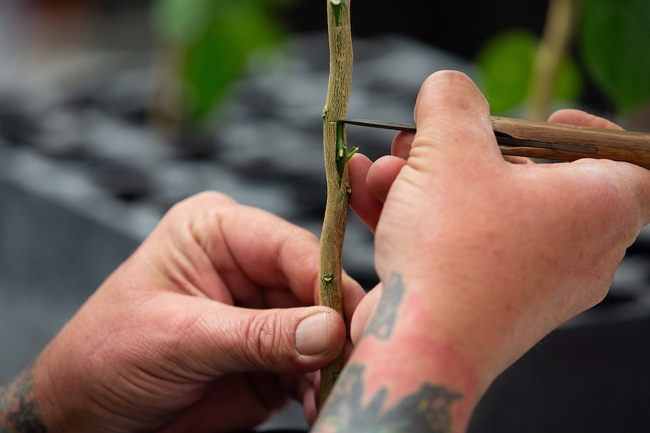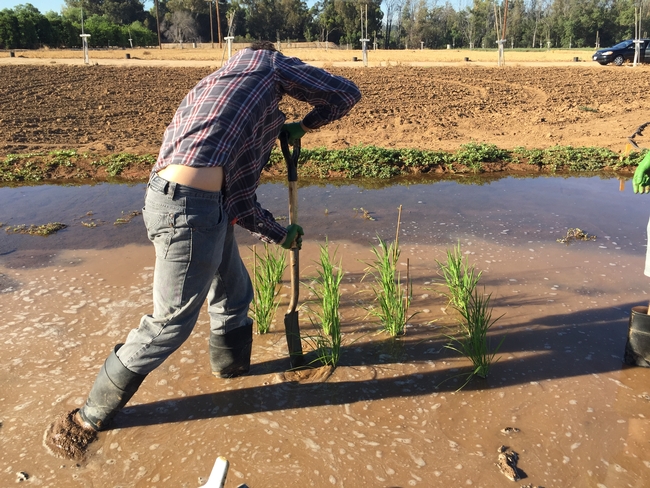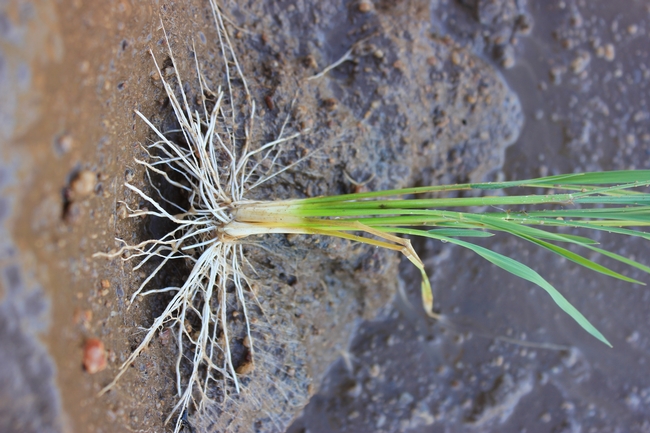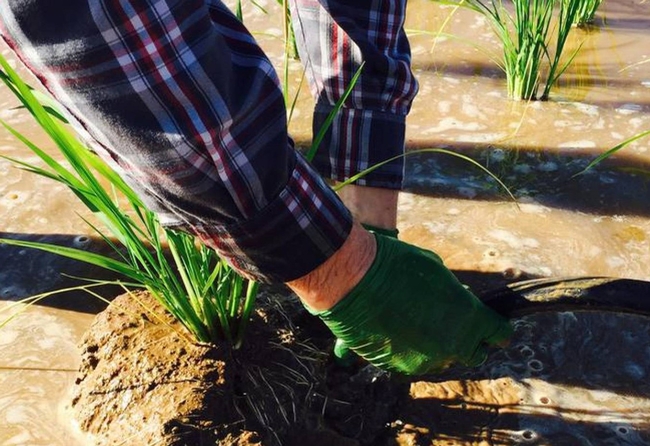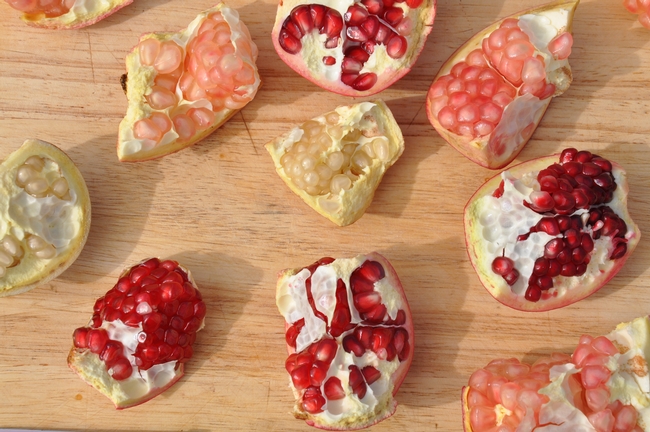Posts Tagged: UC Riverside
You, too, can grow California’s oldest living orange variety
Sweet Mother Orange Tree released from quarantine
The 1000th tree okayed for growing by California's Citrus Clonal Protection Program happens to be the oldest living orange variety in the state.
The program, housed at UC Riverside, is the first of its kind in the world. It began in the 1950s, and its scientists spend up to three years testing and clearing citrus trees of disease so they can be released to commercial and private growers.
By law, every citrus tree newly propagated in California can be traced back to one mother tree created at UCR through the protection program. Program Director Georgios Vidalakis and his group begin their process by testing incoming trees for more than 30 citrus diseases, whether the diseases are known to have emerged in the state or not.
The treatment for any disease identified in that first round of testing is to make a new mini tree from a few cells of the original budwood — short, leafless twigs with buds meant for propagation. “We use special plant cells for this process that diseases cannot penetrate,” Vidalakis said.
After the mini tree grows large enough, program scientists go back and do a second round of testing for disease, making sure they picked the right cells for propagation and eliminating any prior trace of illness.
If it passes the arduous second set of tests, the new tree gets a variety index or VI number that accompanies it for the rest of its life, and it is released to the public.
Dubbed the Mother Orange Tree, Bidwell's Bar is a sweet Mediterranean orange brought to California from Mazatlán, Mexico, and planted in 1856. It was first planted near the Bidwell Bar Bridge near Oroville, then dug up and replanted twice.
Its survival skills are some of the reasons Tom Delfino, former California Citrus Nursery Society director, recommended the old orange tree for the protection program.
“Apparently this variety is very rugged,” Delfino said. “Not only has it survived a lot of cold Northern California winters, but the tree has been dug up and replanted twice — once to protect it from impending flood, and again to make way for the Oroville Dam.”
Much of the state's orange industry is based in areas with warm weather. Delfino, who lives in the San Francisco Bay Area, finds citrus an exciting challenge to grow. By suggesting Bidwell's Bar for approval, he was hoping the protection program would clear it so he could buy its budwood.
On the occasions he has visited the original tree, Delfino said the fruit in reaching distance was always gone. “I think it must be tasty because locals grab it for themselves,” he said. “Makes me even more eager to grow and eat my own. I'm extremely pleased the VI testing is completed so I can acquire it.”
Delfino also hopes that this variety will catch on with commercial growers.
“My thought is our citrus industry is concentrated in the southeastern San Joaquin Valley and is subject to a number of pests that like the warm climate there,” Delfino said. “Though this has seeds, which may be a deterrent, it can be grown in colder areas that discourage some of those insects.”
The tree arrived in California nearly two decades before the better-known Washington Navel orange grown by Eliza Tibbets in Riverside. The navel is named for a structure at the bottom end of the fruit, which resembles a belly button. This structure is actually a separate fruit inside the larger fruit. The Washington Navel is also seedless, contributing to its popularity.
“Bidwell's Bar is an example of what was grown in California before the Washington Navel came to dominate, and now that it has a VI number, others can grow it too,” said Tracy Kahn, curator of the Givaudan Citrus Variety Collection at UCR.
Kahn says it's important to preserve the genetic material from a tree with such significance to California. “Some people were worried it was going to die, but now we have an officially cleared source of this historic tree, and it is protected for future generations,” Kahn said.
New strategies to save the world’s most indispensable grain
Genetic insights help rice survive drought and flood
Plants — they're just like us, with unique techniques for handling stress. To save one of the most important crops on Earth from extreme climate swings, scientists are mapping out plants' own stress-busting strategies.
A UC Riverside-led team has learned what happens to the roots of rice plants when they're confronted with two types of stressful scenarios: too much water, or too little. These observations form the basis of new protective strategies.
“This one crop is the major source of calories for upwards of 45 percent of humanity, but its harvests are in danger,” said Julia Bailey-Serres, UCR geneticist and study lead. “In the U.S., floods rival droughts in terms of damage to farmers' crops each year.”
While it is possible for rice to flourish in flooded soils, the plants yield less food or even die if the water is too deep for too long. This work simulated prolonged floods of five days or longer, in which plants were completely submerged. It also simulated drought conditions.
In particular, the researchers examined the roots' response to both types of conditions, because roots are the unseen first responders to flood and drought-related stress.
Their work is described in a new paper published in the journal Developmental Cell.
One key finding is about a cork-like substance, suberin, that's produced by rice roots in response to stress. It helps protect from floods as well as from drought.
“Suberin is a lipid molecule that helps any water drawn up by the roots make it to the shoots, and helps oxygen from shoots to reach roots,” Bailey-Serres said. “If we reinforce the plant's ability to create suberin, rice has better chances for survival in all kinds of weather.”
The researchers were able to identify a network of genes that control suberin production and can use this information for gene editing or selective breeding.
“Understanding suberin is particularly exciting because it is not susceptible to breakdown by soil microbes, so carbon that the plant puts into suberin molecules in the roots is trapped in the ground,” said Alex Borowsky, UCR computational biologist and study co-author.
The researchers also identified the genes controlling some of rice's other stress behaviors.
“One of our interesting findings is that when rice plants are submerged in water, the root cell growth cycle goes on pause, then switches back on shortly after the shoots have access to air,” Bailey-Serres said.
In the future, the research team plans to test how modifying these stress responses can make the plant more resilient to both wet and dry conditions.
“Now that we understand these responses, we have a roadmap to make targeted changes to the rice genome that will result in a more stress-tolerant plant,” Bailey-Serres said.
Though heavy rains and droughts are both increasing as threats, Bailey-Serres has hope that new genetic technology can increase its resilience before it's too late.
“With genome editing, the fact that we can make a tiny but targeted change and protect a plant from disease is amazing. Though our crops are threatened, new technologies give us reasons to hope,” Bailey-Serres said.
Expanding pomegranate production
John Chater remembers the day vividly. He was about two years old. His grandfather gave him a dark, purplish pomegranate. Happily, he opened it and starting eating.
He quickly realized his mistake. He was wearing his new light brown suede shoes. The pomegranate juice quickly found the shoes, leaving a permanent scar.
“That was my first experience, that I remember, with pomegranates, and it involved getting in trouble,” Chater said. “Because it was so delicious, I didn't realize it would stain.”
More than 30 years later, Chater is a Ph.D. student at the University of California, Riverside, with a focus on pomegranate research and a 2016 University of California Global Food Initiative student fellow. He is building on the work of his grandfather, S. John Chater, who was a maintenance worker at hospital but developed a cult following among rare fruit growers in California for developing new varieties of pomegranates.
The younger Chater, working with varieties selected from the National Clonal Germplasm Repository in Winters, including several developed by his grandfather (who died in 2002), is working to better understand the commercial potential of these varieties.
Currently, 90 to 95 percent of pomegranates are one variety: Wonderful, Chater said. (In addition, California grows more than 95 percent of pomegranates in the United States, he said.)
Working under Don Merhaut, UC Cooperative Extension specialist for ornamental and floriculture crops at UC Riverside, Chater has set up pomegranate variety trials in Riverside and Camarillo.
They have planted 12 pomegranate varieties, 15 trees per variety, to evaluate their establishment, precocity (flowering and fruiting), usefulness to growers and desirability to consumers.
Of the 12 varieties, 10 are edible (Parfianka, Desertnyi, Wonderful, Ambrosia, Eversweet, Haku Botan, Green Globe, Golden Globe, Phoenicia and Lofani) and two are ornamental (Ki Zakuro and Nochi Shibori). The ornamental varieties, whose flowers look like carnations, could be of interest to the floriculture industry, Chater said.
The researchers want consumers to be able to go to supermarket, and, like apples and citrus, be able to buy different varieties of pomegranates that vary in sweetness, seed hardness and color. (The varieties Chater is studying range in color from green to yellow to pink to orange to red to nearly purple.)
Chater set up the trials in Riverside and Camarillo to evaluate the difference between the cooler coastal climate and the warmer inland climate.
The prevailing thought is that more acidic varieties do better in inland conditions because the high summer temperatures reduce the acidity before the fruit is picked in the fall.
For example, a variety such as Wonderful, which is high in acidity, is grown commercially in the Central Valley. But, Eversweet, which has a lower acidity, does well on the coast.
Related to color, some researchers believe that pomegranates color up because of cool night time temperatures. Therefore, trees planted on the coast tend to color up faster.
All that said, it is believed no one has done a comprehensive study, such as the experimentally-designed one Chater has set up, in the United States. It will allow him to study the interplay of variables including size, color, sweetness, acidity, antioxidant activities and seed hardness in different climate conditions.
This story en español.
View a video featuring John Chater and his pomegranate research below:


